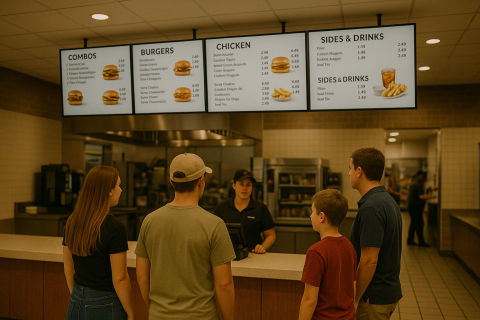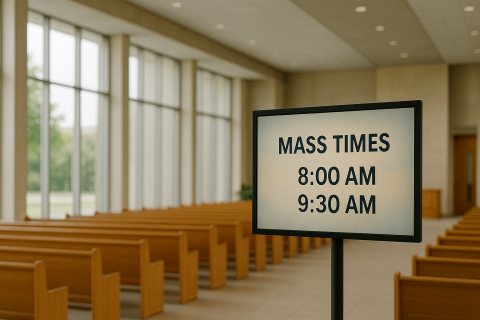If you are looking to launch digital signage in your business, there are a few things you should know before buying digital signage network software. It’s important to be aware of key features and functionality that are vital to a smooth user experience so that you can make informed purchasing decisions. Read the article below to learn more.
What is digital signage network software?
Digital signs are any screen that displays content to viewers. Typically, this content includes promotional material, data dashboards, menus, or company branding. Digital signage does not work by magic, though, and it requires dedicated software to run reliably. This software communicates with digital signage player hardware and cloud servers to render the customer’s content on the screen.
Why is digital signage network software important?
In the past, when a user wanted to update content on a digital sign, they would often have to physically visit each sign in person. During this visit, they would upload new content via a USB drive and edit what showed on the screen with a keyboard. This process was incredibly time-consuming and inefficient, particularly if a digital signage deployment had many screens across one or more cities.
Digital signage software eliminates the need for physical interaction with screens and allows users to add, edit, and schedule digital signage content from anywhere with an internet connection. Instead of spending time traveling to screens and messing with arduous content update workflows, users can now complete content updates in just a few minutes. Users can then focus their time and efforts on content creation and more pressing business tasks.
What features are important in digital signage network software?
The most important feature is content scheduling. Modern digital signage software allows users to schedule their content so that everything is taken care of weeks or even months in advance. For example, a restaurant can program its digital menu boards to show lunch and dinner menus only during specific hours. Additionally, restaurants can schedule special promotions throughout the month.
Be sure that the software you end up going with can support the digital signage content that is important to you. This content is likely photo and video files, but audio may be important, too. Another important consideration is if you want to display content in 1080p or 4K. While 4K content is more visually stunning, it is also more costly to find and produce. In many cases, 4K content is not necessary and is just an added complication.
You should also make sure that your digital signage network software can easily integrate with your favorite applications and tools. Many digital signage software options have an app store or listed tools for which they have a premade solution. These apps can enable companies to get started more quickly and launch digital signs with content that is important to them.
Features that are important for launching digital signs at scale
Another important set of features are those that make it easy to manage digital signage at scale. These features include team permissions and access controls, so you can allow your team to work on your digital signage deployment with you. If you want to allow a team member to update the card on file but not the content on screens, team permissions make this possible. They provide an added fail-safe so that you don’t have to worry about potential mishaps.
Another important feature is remote screen health monitoring, which ensures that you and your team are the first to know when screens or hardware encounter issues. With remote screen health monitoring, users can see the status of all the screens on a visual dashboard. Additionally, users can receive notifications via email or app integrations like Pagerduty that alert them when screens need troubleshooting. The faster your team knows about screen issues, the faster these issues can get resolved. No more days or weeks of an offsite screen not displaying content.
Lastly, it is also important to be able to share content across multiple screens at once with features like screen group labels and shared playlists. With screen group labels, users can deploy content to many screens in just a couple of clicks. For example, they can deploy a promotional offer to all screens with the label “Floor One.” Similarly, shared playlists also help users manage digital signage at scale, as users can share content across multiple company teams, and the teams can decide where this content gets displayed.
Developer-friendly digital signage features
Another important consideration is whether or not your digital signage network software is developer-friendly. Surprisingly, this consideration is important for both developers and non-developers alike.
Sometimes, digital signage software is extremely locked down. The benefit here is that “what you see is what you get,” but a downside is that customizations are not possible. Often, getting a digital signage workflow to operate perfectly for your business requires a few tweaks here and there or custom integration work with your existing hardware and tools. Developer-friendly digital signage makes this customization possible.
Developer-friendly digital signage can include a digital signage API that allows developers to connect their existing tools to their digital signage solution. Relatedly, features like Edge Apps allow users to deploy and manage these custom solutions at scale without having to worry about the behind-the-scenes infrastructure and headaches. Other important developer-friendly features include a digital signage command line interface (CLI) so that developers can more easily write documentation and automation.
How to get started with digital signage network software
The best way to get started with digital signage network software is to, well, get started. With Screenly, we make it easy to try out digital signage without any cost or hardware. You can get started right now with our 14-day free trial, and we do not require a credit card. Once you are inside, check out Screenly for yourself. You can even start displaying content on a web browser virtual screen so you can test out your content and playlists immediately.





